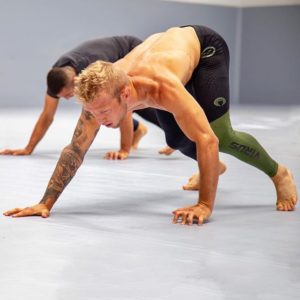If there’s one thing that’s overlooked in almost any type of fitness program or sport (minus yoga, haha!) … it’s flexibility.
Perhaps I shouldn’t say overlooked, but definitely not as valued as it should be. Here, we’ll go over why that is, how flexibility can help with recovery, and the best stretches and moves you can do to stay bendy and recover faster.
Why Is Flexibility So Important In MMA And For Recovery?

It’s easy to focus on improving the things we see making an “impact” in the ring. At first glance, this is usually strength AND speed, as both offer very visible, tangible results when you land a punch or kick.
However, while underrated, flexibility is truly the backbone of both of these aspects we admire.
This is because flexibility of your joints and muscles allows for the range and rotation you need to land knockout blows. Take, for instance, a roundhouse kick: this movement requires more than just core strength and balance. It requires flexible and mobile hips that can rotate fully through the hip joint, while also extending fully through the hip muscles, all of which wouldn’t be possible without flexible hips. A roundhouse kick landed without flexible hips may have an impact, but not the same impact as one that had more momentum due to mobility.
Not to mention, flexibility can play a huge role in gaining strength. For instance, flexible hips can squat deeper than non-flexible hips, which can lead to greater strength gains. Inflexibility can lead to less depth in movements, which can lead to less muscle recruitment, and even to injuries.
When it comes to recovery, stretching also helps improve circulation through your muscles, tendons, and cartilage, which improves the flow of nutrients to needed areas. It also helps your muscles grow more lengthened (i.e.: more flexible) due to stretching them out during the repair process.
Static vs. Dynamic Stretching: Which Is Best?
This is a question I get a lot, mostly because it’s been a debated topic in and of itself for decades. In truth, both have their place in a well-rounded, effective stretch routine.
Dynamic stretches are those that are done with movement, while static stretches are done by holding still in a stretch. Each offer benefits that are essential to holistic flexibility, which is why you’ll see both options below.
Best Stretches To Recover From MMA Training
Practice these stretches after warming up or post-workout. They can be used for recovery, and during or after training sessions to improve your bend-ability.
1. Pigeon Pose
Many movements in fighting start from your hips, and Pigeon is one of the best to target your hip flexors and deep lateral rotators.
To do: Begin sitting down, then move your right leg straight back and behind you. Slide your left leg forward, bent at the knee, bringing your left shin perpendicular to your right leg. Your left leg should be at a 90-degree angle to your torso. Once you’ve achieved that position, lean forward slightly until you feel a deep stretch in over your left leg, hold for 10-15 seconds, then switch.
2. Butterfly Stretch
A great stretch for all the grapplers and jiu-jitsu folks out there, Butterfly targets your groin, hips, and lower back.
To do: Sit with the soles of your feet touching in front of you. Lean forward over your legs, avoiding letting your knees float upward. To get a deeper stretch, slide your feet in towards your groin and lean forward more.
3. Scorpion Stretch
Scorpion stretches your quads, lower back, and opens up your chest and torso.
To do: Lie down flat on the ground with your face facing downward. Stretch out your arms in front of you, palms facing downward. Raise your right leg and bring it up and over to the left side of your lower back. Using your hands to grasp and hold your ankle, try to press your heel toward your butt. Hold for 5-10 seconds. Bring your leg back to its original position and repeat on the other side.
4. Hip to Twist
This dynamic stretch loosens up your thighs, groin, and core, while giving you a deep hip and spinal stretch.
To do: Start in the pushup position and bring your right foot up to your right hand while keeping your hips down and lower back flat. Lift your left hand, twist to your left while extending your arm and reaching toward the sky. Come back to the starting pushup position and repeat on the other side.
5. Standing Hamstring Stretch
If your hamstrings are tight from a day or deadlifts, squats, or box jumps, stretch them out easily with this one.
To do: Extend one leg out by placing the heel on a slightly raised surface, such as a stair or curb. Keeping your spine straight, bend at the hip to bring the chest toward the thigh. The other leg that is not being stretched will also bend slightly at the knee. Hold for 10 to 30 seconds, then switch legs.
Other Tips For Recovery
Other ways to maximize recovery from intense training are things you can (and should!) do on the regular to keep yourself motivated (aka: eating that soreness!) and healing efficiently.
• Epsom salt baths (magnesium helps ease muscle soreness)
• Foam rolling (breaks up knots and improves circulation)
• Infrared sauna (helps repair tissue and improves circulation)
• Massage, either self or with a professional
• Active rest, such as walking or light swimming
